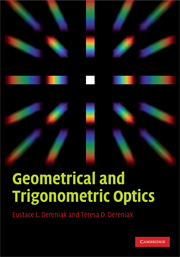Book contents
- Frontmatter
- Contents
- Preface
- 1 Light propagation
- 2 Reflections and refractions at optical surfaces
- 3 Image formation
- 4 Mirrors and prisms
- 5 Curved optical surfaces
- 6 Thin lenses
- 7 Thick lenses
- 8 Mirrors
- 9 Optical apertures
- 10 Paraxial ray tracing
- 11 Aberrations in optical systems
- 12 Real ray tracing
- Appendix A Linear prism dispersion design
- Appendix B Linear mixing model
- Appendix C Nature's optical phenomena
- Appendix D Nomenclature for equations
- Appendix E Fundamental physical constants and trigonometric identities
- Glossary
- Index
- References
7 - Thick lenses
Published online by Cambridge University Press: 06 July 2010
- Frontmatter
- Contents
- Preface
- 1 Light propagation
- 2 Reflections and refractions at optical surfaces
- 3 Image formation
- 4 Mirrors and prisms
- 5 Curved optical surfaces
- 6 Thin lenses
- 7 Thick lenses
- 8 Mirrors
- 9 Optical apertures
- 10 Paraxial ray tracing
- 11 Aberrations in optical systems
- 12 Real ray tracing
- Appendix A Linear prism dispersion design
- Appendix B Linear mixing model
- Appendix C Nature's optical phenomena
- Appendix D Nomenclature for equations
- Appendix E Fundamental physical constants and trigonometric identities
- Glossary
- Index
- References
Summary
A real lens has axial thickness, two radii of curvature, one for each surface (front and back), as well as some non-zero edge thickness. The line connecting the two centers of curvature is the optical axis. Thus far, we have disregarded the axial thickness of a lens by making it zero (t = 0). This produced a set of equations for a thin lens that relate the conjugate planes of the object and image. The t = 0 assumption gave the thin lens an optical power approximately equal to that of the thick lens. These equations were developed in order to solve paraxial optical relationships with analytical functions instead of ray tracing, resulting in a body of knowledge referred to as Gaussian optics. The real refractive lens has to have some axial thickness in the most common cases, except for the cases of spherical mirrors and single refracting surfaces (SRS), which mimic thin lenses.
Therefore, for real refractive lenses, the question becomes: from what surface or location does one measure the focal lengths, object distances, and image distances for a given setup? Chapter 6 showed that one can determine the optical power of a thick lens; however, the fiducial points from which to measure these distances were not determined. The cardinal points of a thick lens system will be explored in this chapter. Recall there are six cardinal points: two principal points, two focal points, and two nodal points, as was discussed for the thin lens.
- Type
- Chapter
- Information
- Geometrical and Trigonometric Optics , pp. 164 - 192Publisher: Cambridge University PressPrint publication year: 2008



